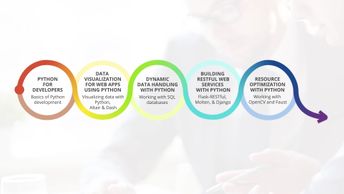Final Exam: Resource Optimization with Python - add noise to an image
- add noise to an image and apply a blur
- add noise to an image and apply a blur which obscures minute details in an image
- aggregate data on a per-key, per-window basis
- apply cv2.resize to scale up an image along individual dimensions
- apply the Laplacian operator to detect the edges in an image
- apply the Laplacian, Sobel and Canny operators to detect the edges in an image
- compute aggregations on streaming data
- contrast tumbling windows and hopping windows
- create a workspace for the demos and install OpenCV from a Jupyter notebook
- create models with multiple fields and different data types
- draw a polygon and an arrow in an OpenCV image and introduce a text element
- forward messages to destination topics
- handle GET, PUT, POST, DELETE, HTTP requests with web views
- identify attributes of hopping tumbling
- identify attributes of tumbling windows
- identify the components that make up the architecture of a stream processing system
- identify the differences between event time, ingestion time, and processing time
- identify the different kinds of sinks that can be used with a Faust agent
- identify the results of bitwise AND, OR, NOT and XOR operations on images
- implement event time hopping windows
- implement gaussian and median blur operations in order to smooth an image
- implement processing time tumbling windows
- implement the cv2.resize method to reduce the size of a color image
- implement the "faust" command to run workers and send messages to agents
- implement the key index to iterate over keys, values, and items in windowed tables
- implement the subtract method in OpenCV to perform a subtract operation between two images
- implement trained classifiers to detect eyes, faces and people in images
- invoke the cast() method to await processing results from an agent
- list the components that make up the architecture of a stream processing system
- load images from your file system into an OpenCV array and then perform the reverse operation by saving an array into a local file
- perform a variety of translations and rotations in increments of 90 degrees in order to orient an image according to your specifications
- perform gaussian and median blur operations in order to smooth an image
- perform group-by operations on streams
- perform grouping operations and understand table sharding
- plot a circle, line, rectangle and ellipse in an image
- publish messages to a Kafka topic using the pykafka library
- read a color image into your Python source
- read a color image into your Python source as a grayscale image
- read a color image into your Python source as a grayscale image and view it using an interactive window
- recall the differences between event time, ingestion time, and processing time
- recall the different kinds of sinks that can be used with a Faust agent
- recall the important characteristics of the Faust stream processing applications
- recognize the results of bitwise AND, OR, NOT and XOR operations on images
- recognize the use of the BGR and RGB color spaces used by OpenCV and the Pillow libraries
- save table state to an embedded RocksDB database
- send and receive messages using channels
- separate a color image into blue, green and red channels
- use channels to send and receive messages
- use models to represent stream elements
- use the add and addWeighted methods in OpenCV to combine two images
- use the cv2.resize method to reduce the size of a color image
- use the "faust" command to run workers and send messages to agents
- use the key index to iterate over keys, values, and items in windowed tables
- use the pykafka library to publish messages to a Kafka topic
- use the subtract method in OpenCV to perform a subtract operation between two images
- use trained classifiers to detect eyes, faces and people in images
- use trained classifiers to detect faces and people in images
- use web views to handle GET, PUT, POST, DELETE, HTTP requests
- using trained classifiers to detect faces, eyes and people in images
|


